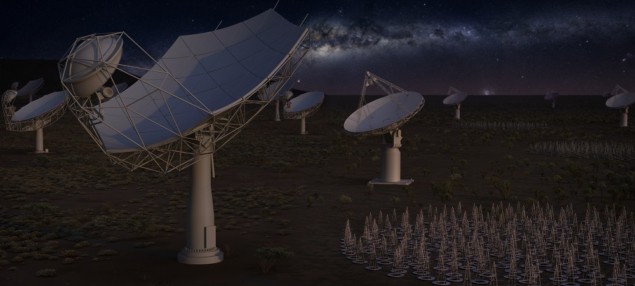
Plans to build the world’s largest radio telescope, known as the Square Kilometre Array (SKA), have suffered another setback after it emerged that the estimated cost of the observatory has risen by €100m over the past year. Project organizers are confident that the price hike can be met by contributions from new member states, but it is also possible that an already slimmed-down design will be shrunk further.
Once complete, the SKA is expected to consist of thousands of mid-frequency radio dishes spread out across southern Africa and a million low-frequency dipole antennas located in Australia. Given the project’s expected multi-billion Euro price tag, however, its 10 current member states have concentrated on designing a smaller version of the telescope known as SKA 1.
We have 18 months before we plan to start construction activities, and even then we don’t have to have all the funding committed on day one
Philip Diamond
Proposed in 2013, SKA 1 initially envisaged 250 dishes and 250,000 antennas being built so that costs are kept below a cap of €674m. But that design has since had to be cut back twice following price rises, and there could now be additional trimming in the wake of reviews by consortia set up to work on different aspects of the design. In a meeting of member states held at the SKA Organisation’s headquarters at Jodrell Bank in the UK in July, the organisation’s deputy director general Joe McMullin revealed that construction costs for the “design baseline” now stand at €914m (in 2017 prices). A year ago that figure was €814m.
Cost caps
McMullin’s boss, director general Philip Diamond, says he hopes that the capped funding, currently set at €691m, will be provided by the countries who signed a treaty in March to set up an intergovernmental body for the observatory’s construction — Australia, China, Italy, the Netherlands, Portugal, South Africa and the UK – as well as perhaps Canada, India and Sweden. New Zealand announced last month that it was pulling out of the project, and Diamond will not say which of the other members has promised funding. But he points out that the Netherlands recently became the first country to ratify the treaty, describing the mood among members and potential members as “very positive”. New Zealand pulls out of the Square Kilometre Array after benefits questioned
Diamond says that the single biggest contributor to the latest price hike has been a rise in contingency costs. This is to cover unexpected increases in the cost of steel, fibre and electronic components, for example, which he says had been underestimated by the design consortia. He hopes that the arrival of new member countries, such as Spain or France, will cover the difference between the cost cap and the price of the design baseline, maintaining that there is plenty of time to negotiate terms with new members. “We have 18 months before we plan to start construction activities, and even then we don’t have to have all the funding committed on day one,” he says, adding that construction should be complete by 2028.
Diamond says the project could still go ahead even if all of the funding is not forthcoming, given that the SKA, as he puts it, “is inherently scalable”. Heino Falcke, a radio astronomer at Radboud University in the Netherlands, agrees. He points out that costs can be saved by building fewer antennas or reducing computing power, for example. “Not all of those will kill science cases, but rather may delay them,” he says. “It depends on the magnitude. It is not like you have a fixed launch date, where everything has to be ready and functional – you can and you will expand as you go.” But, he adds: “It still can hurt”.
Timeline: The Square Kilometre Array
2006
Southern Africa and Australia are shortlisted to host the Square Kilometre Array (SKA) beating off competition from Brazil and China. Due to be completed in 2020 and cost €1.5bn, the facility would comprise about 4000 dishes, each 10 m wide, spread over an area 3000 km across
2012
The SKA Organisation fails to pick a single site for the telescope and decides to split the project between Southern Africa and Australia
Philip Diamond is appointed SKA’s first permanent director-general replacing the Dutch astronomer Michiel van Haarlem, who had been interim SKA boss
2013
Germany becomes the 10th member of SKA, joining Australia, Canada, China, Italy, the Netherlands, New Zealand, South Africa, Sweden, the UK
SKA’s temporary headquarters at Jodrell Bank in the UK opens
SKA members propose a slimmed-down version of SKA known as SKA1. With a cost cap of €674m, it would consist of 250 dishes in Africa and about 250 000 antennas in Australia
2014
Germany announces it will pull out of SKA the following year
2015
Jodrell Bank beats off a bid by Padua in Italy to host SKA’s headquarters
India joins SKA
2017
Members scale back SKA again following a price hike of €150m, which involves reducing the number of African dishes to 130 and spreading them out over 120 km
2018
The first prototype dish for SKA is unveiled in China
Spain joins SKA
2019
Convention signed in Rome to create an intergovernmental body known as the SKA Observatory
The Max Planck Society in Germany joins SKA
New Zealand announce it will pull out of SKA in 2020



